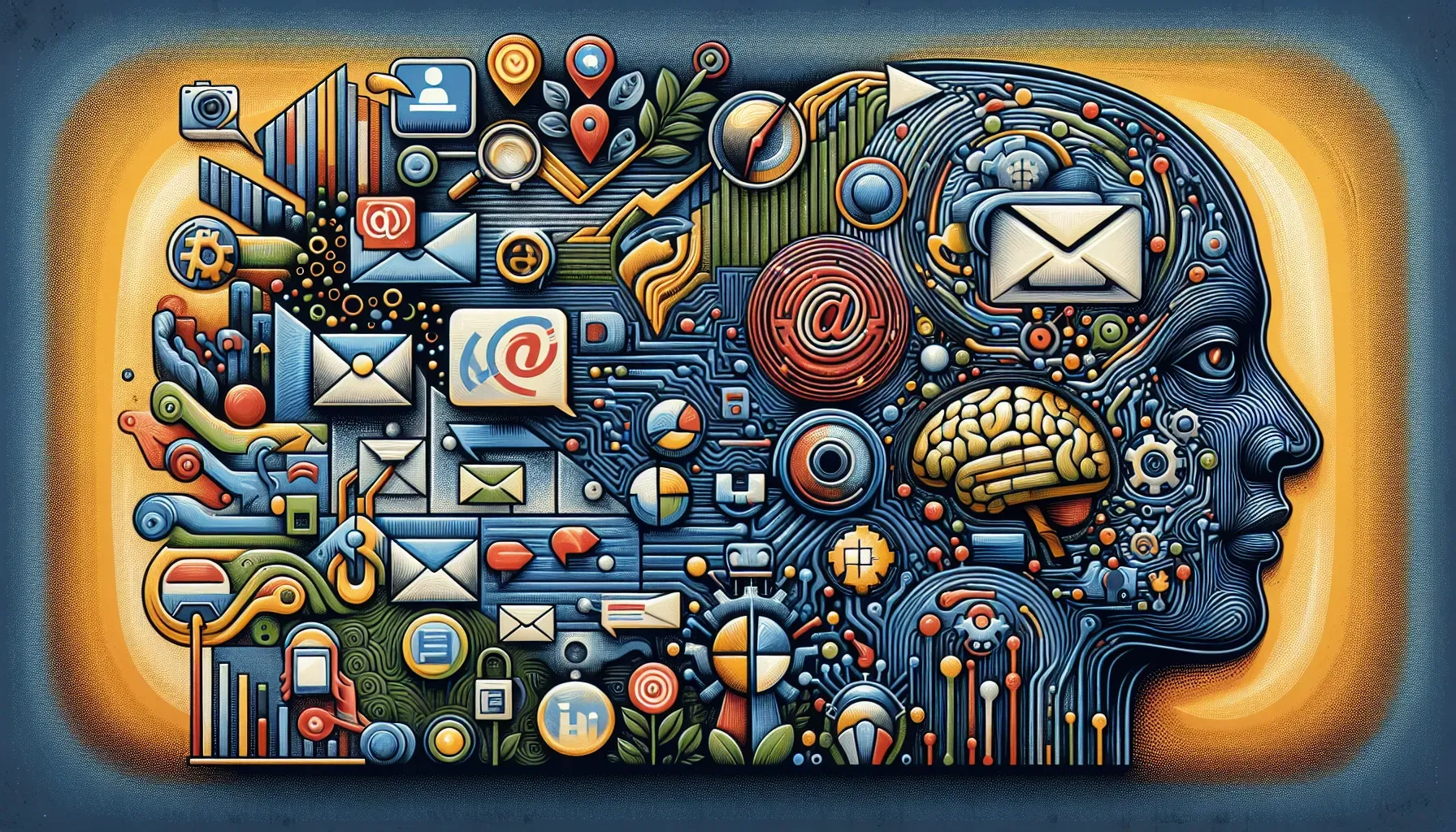Traditional Email Campaigns vs. Chatbot Messaging: Revolutionizing Direct Communication

In the dynamic landscape of digital marketing, the evolution of communication channels has significantly impacted how businesses engage with their audience. Traditional email campaigns and chatbot messaging stand at the forefront of direct communication strategies, each offering unique advantages and challenges. In this comprehensive exploration, As we delve into the comparative analysis of traditional email campaigns and chatbot messaging, shedding light on their open rates, personalization capabilities, integration strategies, the future of automated customer service and direct marketing communication, successful case studies, consumer perspective, and navigating GDPR and privacy concerns.
Comparing Open Rates and Engagement: Email vs. Chatbots
Email campaigns have long been a staple in digital marketing due to their wide reach and established user familiarity. However, the open rates and engagement metrics of traditional email campaigns have experienced fluctuations over time, often affected by factors such as inbox clutter, spam filters, and changing user behaviors. On the other hand, chatbot messaging presents a novel approach to direct communication, often yielding higher open rates and engagement due to its interactive nature and real-time responsiveness.
By recognizing that while email campaigns may have lower open rates compared to chatbots in some instances, they still boast higher conversion rates in certain target demographics. This indicates that understanding the audience's preferences and aligning them with the most suitable communication channel is pivotal for businesses aiming to optimize their direct communication strategies.
Personalization has become integral to successful marketing endeavors, resonating with audiences on a deeper level and fostering brand loyalty. Traditional emails offer a level of personalization through segmenting and targeted messaging. However, AI-driven chatbots have revolutionized personalization by leveraging machine learning algorithms to understand user preferences, history, and behavior in real-time, thereby delivering hyper-personalized interactions that mimic human conversation.
Personalization Capabilities: Traditional Emails vs. AI-Driven Chatbots
By acknowledging that businesses must carefully balance personalization in both email campaigns and chatbot messaging to create meaningful connections with their audience while avoiding intrusive or off-putting tactics. Successfully integrating tailored content based on individual preferences can significantly influence overall engagement and conversion rates for both communication channels.
Businesses aiming to integrate chatbots into their marketing strategy must navigate the delicate balance between automation and human touch. As we highlight the importance of infusing chatbot interactions with personalized, empathetic responses that emulate human conversation. This human touch contributes to building trust and rapport with users, ultimately enhancing the overall customer experience.
Furthermore, optimizing chatbot scripts with natural language processing (NLP) capabilities ensures that interactions feel organic and genuine. This approach helps in creating seamless transitions between automated responses and human intervention when necessary, providing users with a coherent and empathetic brand experience.
Related Article: Bridging The Virtual Gap: Revolutionizing Customer Interactions with AR in Digital Marketing
Integrating Chatbots into Your Marketing Strategy
As technology continues to advance at an unprecedented pace, the future of automated customer service and direct marketing communication appears increasingly intertwined with AI-driven solutions such as chatbots. ClicksBuzz Blog envisions a landscape where chatbots seamlessly anticipate user needs through predictive analytics, enabling businesses to proactively address customer queries and provide personalized recommendations in real-time.
Moreover, as natural language understanding (NLU) capabilities enhance the conversational abilities of chatbots, they are likely to revolutionize direct marketing communication by enabling more sophisticated interactions that closely mimic human dialogue. As such, it is evident that integrating chatbots into marketing strategies will play a pivotal role in shaping the future of customer engagement.
The Future of Automated Customer Service and Marketing Communication
Examining real-world examples of successful integration is paramount for understanding the potential impact of combining chatbots with traditional email campaigns. ClicksBuzz Blog presents insights from industry leaders who have strategically merged these communication channels to create synergy in their marketing efforts.
Notably, brands harnessing the personalized nature of chatbot conversations alongside the broader reach of email campaigns have reported heightened engagement levels and enhanced customer satisfaction. From proactive service notifications to interactive product recommendations, these case studies spotlight innovative approaches that leverage both email campaigns and chatbot messaging to deliver maximal impact.
Case Studies: Successful Integration of Chatbots and Email Campaigns
Understanding the consumer standpoint is essential for assessing the effectiveness of email campaigns versus chatbot interactions. As we emphasize that while some users prefer the familiarity of emails where they can consume information at their own pace, others appreciate the immediacy and interactivity offered by chatbot interactions.
This user experience showdown underscores the significance of offering choice and flexibility in communication channels to accommodate diverse consumer preferences. By aligning direct communication strategies with user behavior patterns, businesses can drive meaningful engagements while nurturing long-term relationships with their audience.
The regulatory landscape surrounding data protection poses inherent challenges for both email campaigns and chatbot messaging. By recognizing the critical importance of ensuring compliance with regulations such as GDPR (General Data Protection Regulation) while orchestrating direct communication strategies.
User Experience Showdown: Email Campaigns vs. Chatbot Interactions
Businesses must prioritize transparency regarding data usage, obtain explicit consent from users for communications, and implement robust security measures to safeguard personal information. By adopting ethical data practices across both email campaigns and chatbot interactions, companies demonstrate respect for user privacy while building trust within their customer base.
In conclusion, as businesses navigate the intricate terrain of direct communication strategies within the digital marketing domain, acknowledging the synergistic potential between traditional email campaigns and chatbot messaging is imperative for driving impactful engagements. Leveraging insights from open rates and engagement metrics alongside harnessing advanced personalization capabilities can empower brands to create compelling narratives that resonate with their audience while maintaining a human-centric approach within an increasingly automated landscape.
Frequently Asked Questions
Email campaigns traditionally have lower open rates due to factors like inbox clutter and spam filters. In contrast, chatbots often achieve higher engagement levels because of their interactive nature and real-time responsiveness, making them appealing for direct communication strategies.
Traditional emails utilize segmentation and targeted messaging for personalization. However, AI-driven chatbots enhance this by employing machine learning algorithms to analyze user behavior in real-time, allowing for hyper-personalized interactions that closely resemble human conversation.
Yes, businesses can successfully integrate chatbots by balancing automation with a human touch. This involves crafting chatbot interactions that include personalized responses and empathetic communication, which helps build trust and enhances the overall customer experience.
The future of automated customer service is likely to be dominated by AI-driven solutions like chatbots. These technologies will increasingly use predictive analytics to anticipate user needs, enabling proactive responses and personalized recommendations that enhance customer engagement.
Successful case studies show brands combining chatbots with email campaigns to increase engagement and customer satisfaction. By leveraging the personalized nature of chatbot interactions alongside the broad reach of emails, these brands have achieved significant marketing synergy.
Consumer preferences vary; some users favor emails for their familiarity and ability to consume information at their own pace, while others appreciate the immediacy and interactivity of chatbot interactions. Offering both options can cater to diverse consumer needs.
Businesses must navigate privacy concerns by ensuring compliance with regulations like GDPR. This includes being transparent about data usage, obtaining user consent for communications, and implementing strong security measures to protect personal information during interactions.
Yes, personalization is crucial in both channels. It fosters deeper connections with audiences and enhances brand loyalty. Businesses should carefully balance personalization efforts to avoid intrusive tactics while still delivering tailored content that resonates with users.
NLP enhances chatbot interactions by enabling them to understand and respond in a more human-like manner. This technology allows chatbots to process user inputs more effectively, creating seamless transitions between automated responses and human assistance when needed.
A balance between automation and a human touch is vital for building trust and rapport with customers. Infusing empathy into automated responses ensures that users feel valued, enhancing their overall experience and fostering long-term relationships with the brand.
Check Out These Related Articles

The Power of Visual Search in Digital Marketing: Strategic Insights and Future Projections

Immersive Experiences Redefining Customer Engagement: AR and VR Dominate Digital Marketing Frontiers

The Era of Augmented Reality Advertising: Crafting Immersive Brand Experiences

